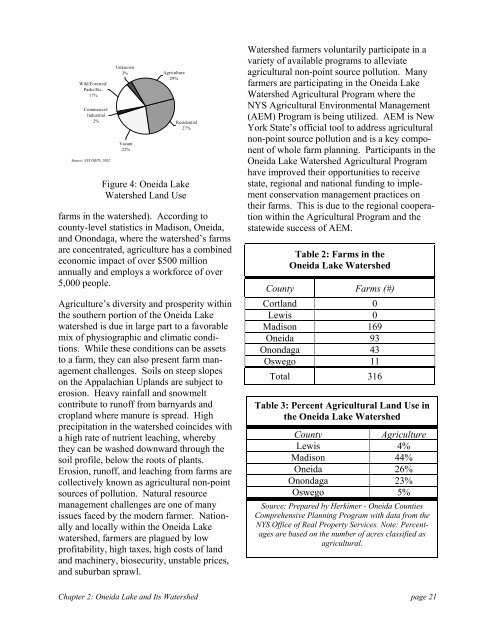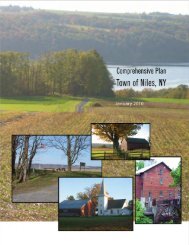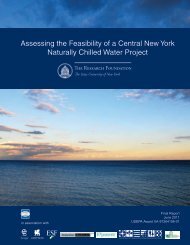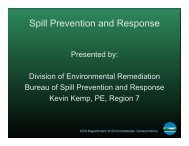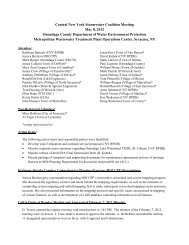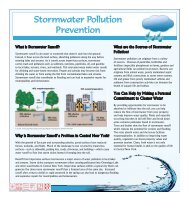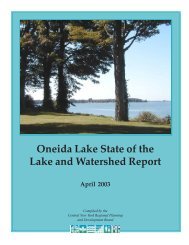A Management Strategy for Oneida Lake and its ... - CNY RPDB Home
A Management Strategy for Oneida Lake and its ... - CNY RPDB Home
A Management Strategy for Oneida Lake and its ... - CNY RPDB Home
You also want an ePaper? Increase the reach of your titles
YUMPU automatically turns print PDFs into web optimized ePapers that Google loves.
Wild/Forested/<br />
Parks/Etc.<br />
17%<br />
Commercial/<br />
Industrial<br />
2%<br />
Source: NYS ORPS, 2002<br />
Unknown<br />
3%<br />
Vacant<br />
22%<br />
Agriculture<br />
29%<br />
Residential<br />
27%<br />
Figure 4: <strong>Oneida</strong> <strong>Lake</strong><br />
Watershed L<strong>and</strong> Use<br />
farms in the watershed). According to<br />
county-level statistics in Madison, <strong>Oneida</strong>,<br />
<strong>and</strong> Onondaga, where the watershed’s farms<br />
are concentrated, agriculture has a combined<br />
economic impact of over $500 million<br />
annually <strong>and</strong> employs a work<strong>for</strong>ce of over<br />
5,000 people.<br />
Agriculture’s diversity <strong>and</strong> prosperity within<br />
the southern portion of the <strong>Oneida</strong> <strong>Lake</strong><br />
watershed is due in large part to a favorable<br />
mix of physiographic <strong>and</strong> climatic conditions.<br />
While these conditions can be assets<br />
to a farm, they can also present farm management<br />
challenges. Soils on steep slopes<br />
on the Appalachian Upl<strong>and</strong>s are subject to<br />
erosion. Heavy rainfall <strong>and</strong> snowmelt<br />
contribute to runoff from barnyards <strong>and</strong><br />
cropl<strong>and</strong> where manure is spread. High<br />
precipitation in the watershed coincides with<br />
a high rate of nutrient leaching, whereby<br />
they can be washed downward through the<br />
soil profile, below the roots of plants.<br />
Erosion, runoff, <strong>and</strong> leaching from farms are<br />
collectively known as agricultural non-point<br />
sources of pollution. Natural resource<br />
management challenges are one of many<br />
issues faced by the modern farmer. Nationally<br />
<strong>and</strong> locally within the <strong>Oneida</strong> <strong>Lake</strong><br />
watershed, farmers are plagued by low<br />
profitability, high taxes, high costs of l<strong>and</strong><br />
<strong>and</strong> machinery, biosecurity, unstable prices,<br />
<strong>and</strong> suburban sprawl.<br />
Watershed farmers voluntarily participate in a<br />
variety of available programs to alleviate<br />
agricultural non-point source pollution. Many<br />
farmers are participating in the <strong>Oneida</strong> <strong>Lake</strong><br />
Watershed Agricultural Program where the<br />
NYS Agricultural Environmental <strong>Management</strong><br />
(AEM) Program is being utilized. AEM is New<br />
York State’s official tool to address agricultural<br />
non-point source pollution <strong>and</strong> is a key component<br />
of whole farm planning. Participants in the<br />
<strong>Oneida</strong> <strong>Lake</strong> Watershed Agricultural Program<br />
have improved their opportunities to receive<br />
state, regional <strong>and</strong> national funding to implement<br />
conservation management practices on<br />
their farms. This is due to the regional cooperation<br />
within the Agricultural Program <strong>and</strong> the<br />
statewide success of AEM.<br />
Table 2: Farms in the<br />
<strong>Oneida</strong> <strong>Lake</strong> Watershed<br />
County Farms (#)<br />
Cortl<strong>and</strong> 0<br />
Lewis 0<br />
Madison 169<br />
<strong>Oneida</strong> 93<br />
Onondaga 43<br />
Oswego 11<br />
Total 316<br />
Table 3: Percent Agricultural L<strong>and</strong> Use in<br />
the <strong>Oneida</strong> <strong>Lake</strong> Watershed<br />
County<br />
Agriculture<br />
Lewis 4%<br />
Madison 44%<br />
<strong>Oneida</strong> 26%<br />
Onondaga 23%<br />
Oswego 5%<br />
Source: Prepared by Herkimer - <strong>Oneida</strong> Counties<br />
Comprehensive Planning Program with data from the<br />
NYS Office of Real Property Services. Note: Percentages<br />
are based on the number of acres classified as<br />
agricultural.<br />
Chapter 2: <strong>Oneida</strong> <strong>Lake</strong> <strong>and</strong> Its Watershed page 21


